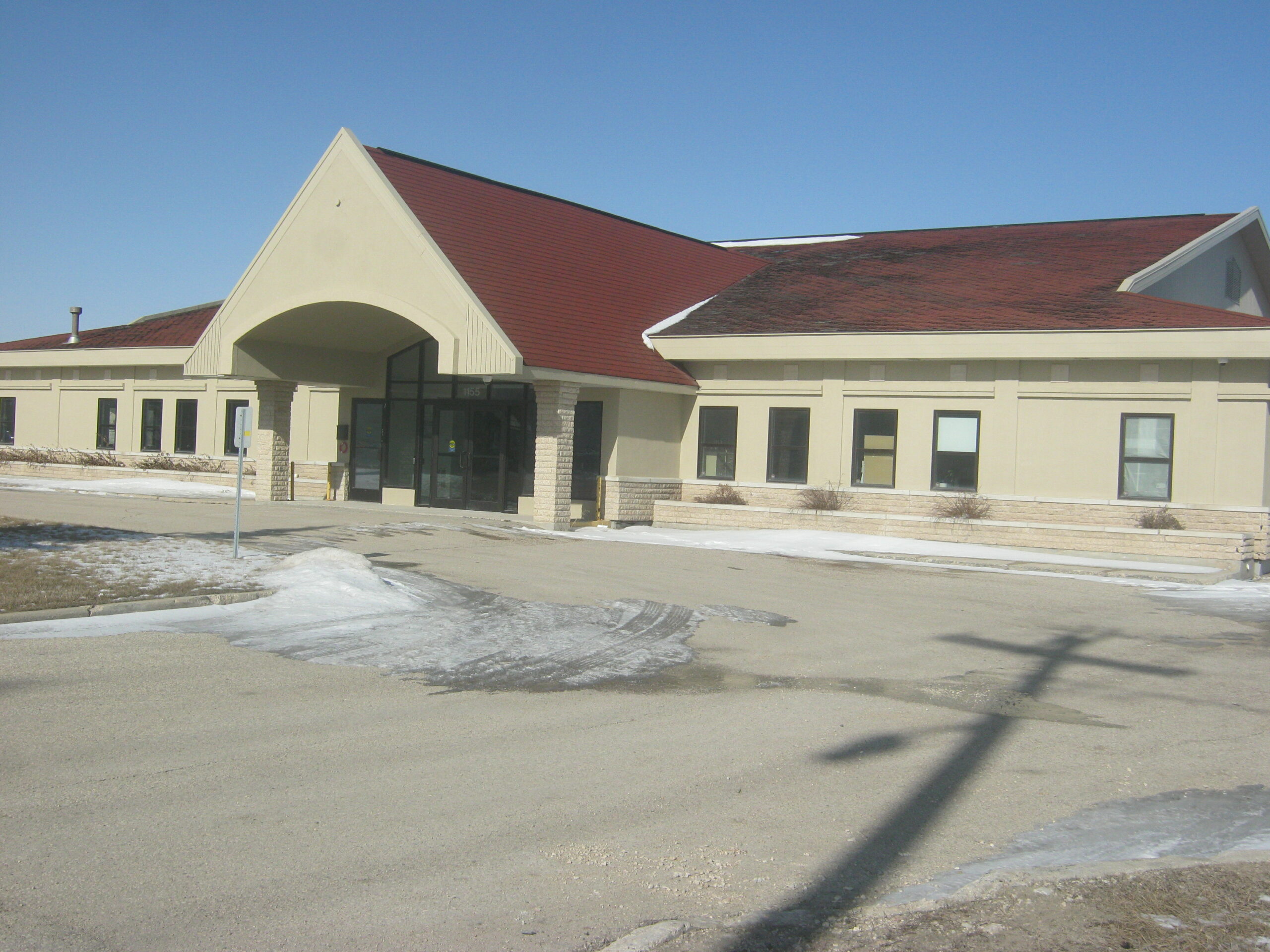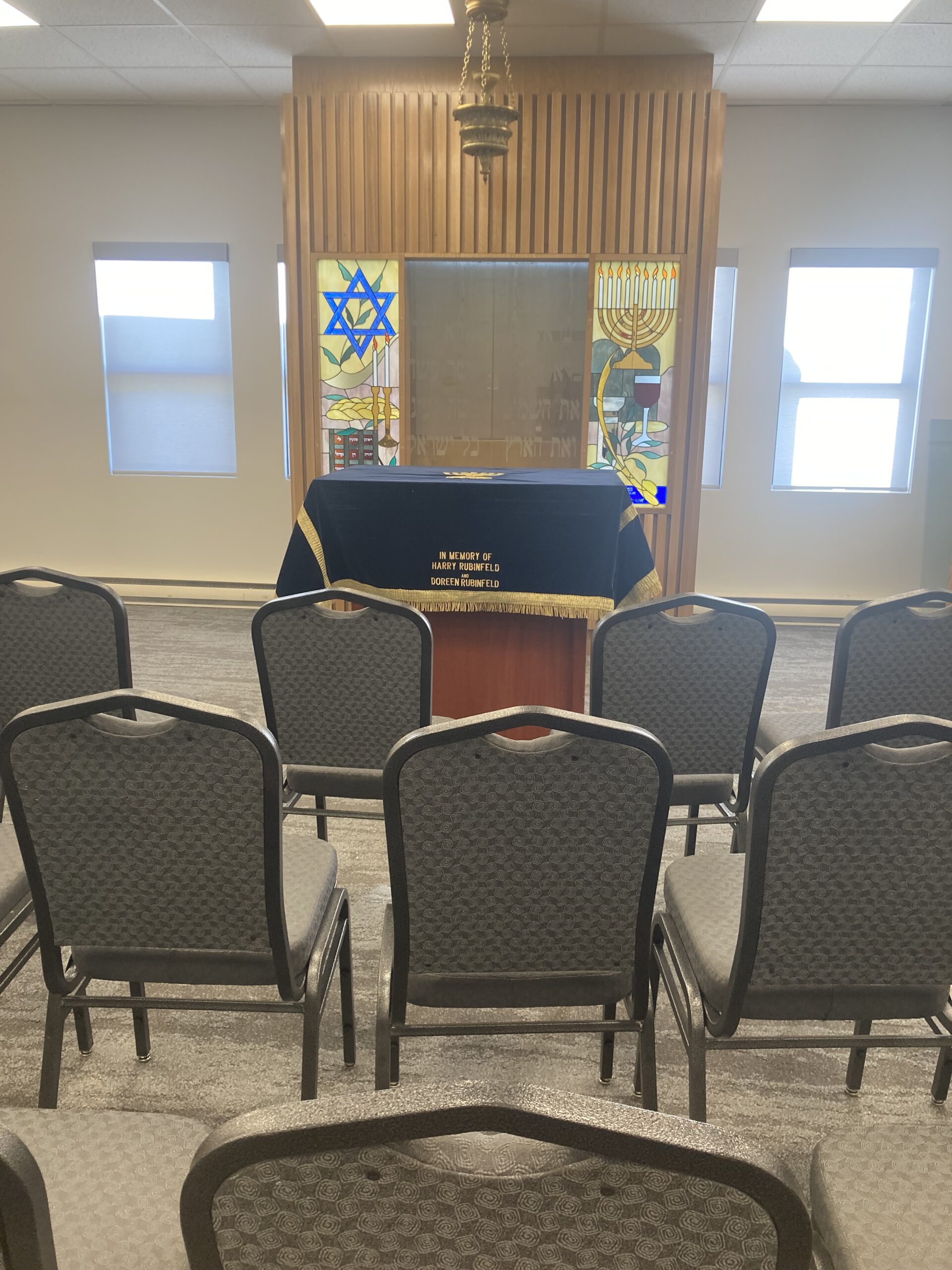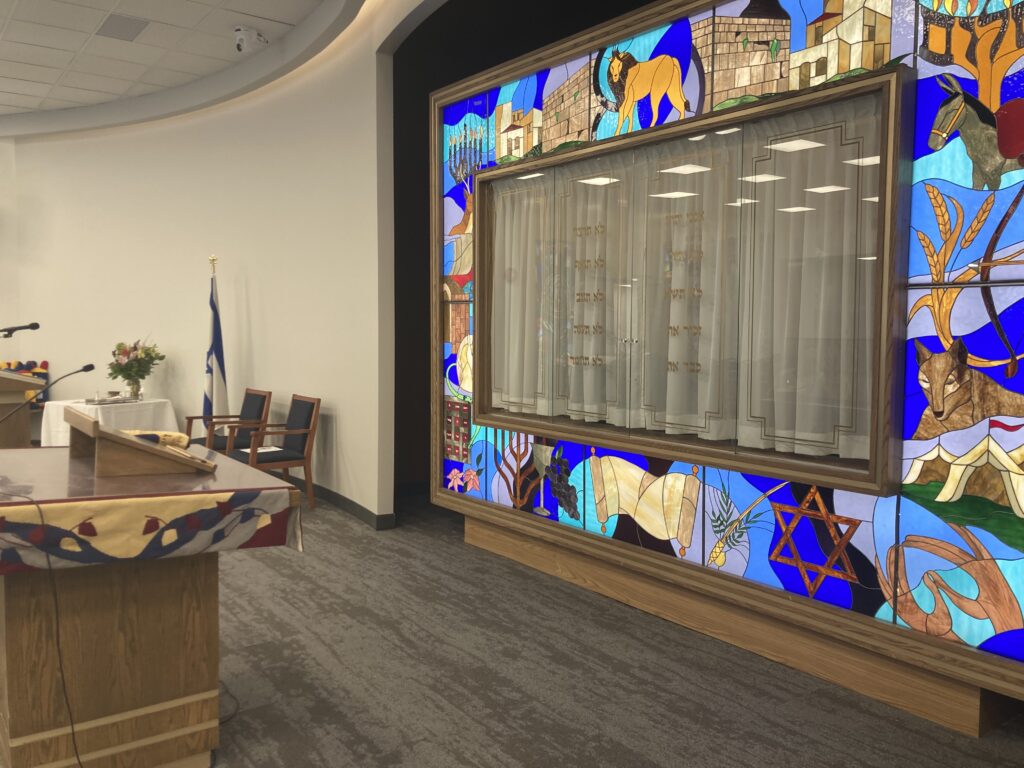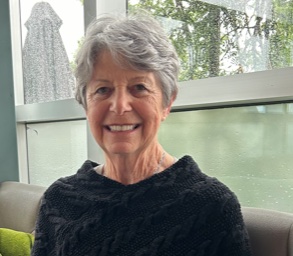Local News
Congregants give new Etz Chayim building two thumbs up

By MYRON LOVE To borrow from the late movie reviewers Roger Ebert and Gene Siskel, long time members are giving the new Etz Chayim building the two-thumbs up seal of approval.
“It’s beautiful,” says Brenda Keller who has been an Etz Chayim member – and the Rosh Pina before it – since 1990. “I love it,” the Garden City resident continues. I especially like what we did with the stained glass windows. The building has a nice, haimishe feel.”

Gary Jacobson concurs. He also really likes how the stained glass windows from the old building have been incorporated into the new. “The sanctuary is very nice,” observes the St. Vital resident, who has been a member of the congregation since 2002 when the former Rosh Pina merged with the North End Beth Israel and Bnay Abraham congregation to form Etz Chayim. “The acoustics and the lighting are both very good.”

The new Congregation Etz Chayim shul – at 1155 Wilkes in the south end – opened its doors at the beginning of March, culminating years of discussions about following our Jewish community’s demographic trends and moving south. Discussions even predating the 2002 merger of the three North end synagogues have been ongoing for several years about a move south. The issue came to a head about 18 months ago. Faced with a declining membership, a 70-plus year old (former Rosh Pina) building that needed a lot of work and had become too large for the existing membership combined with the fact that 70% of the members and 80% of the younger members lived south – the decision was finally made to take action.
“We just felt that it made more sense to put our money into buying a smaller, pre-existing building south and renovating it,” said Etz Chayim’s president, Avrom Charach, in an earlier interview. “We were looking for a location within a ten minute drive from most of our members,” Charach reported.
The congregation was able to purchase just a building – a facility that had been the Khartum Shriners’ headquarters. Etz Chayim sold their former building to an Eritrean Christian congregation.
The reconfigured new location – designed by leading architect and congregation member Ed Calnitsky – was originally supposed to have been re-opened in early December. But, as often happens with construction projects and renovations, the best-laid plans rarely go off without some hiccups.
“Our new building feels very comfortable,” Charach says today. “And our acoustics are much better.”

The sanctuary can accommodate up to 350 people – about the same number as could be seated comfortable in the old building. In the former building the sanctuary though could be doubled in size by removing the barrier that separated it from the auditorium. The 1155 Wilkes location doesn’t have an auditorium – but it does have a kiddush room large enough for 100 people. After Shabbat services, if necessary, the sanctuary can be rearranged for additional tables and food stations for Kiddush.
The kitchen, Charach points out, is smaller than the kitchen at 123 Matheson. “We can still prepare kiddushes and provide for smaller functions with our caterer,” Charach notes. “For larger simchas and programs, we have an arrangement with our caterer, Lisa Odwak, who can prepare in a kosher kitchen and bring the food to the shul.”
Overall, Charach observes, the smaller facility is less expensive and easier to operate.
Outside, there is parking for up to 170 vehicles.
The synagogue membership stands at around 400 families, Charach reports. “We have had a few more join over the past three months,” he says.
He is happy to report that, for the first Shabbat, more than 200 were in attendance and, while the number was down considerably for the second Shabbat, it was still substantial.
“I think that we can look forward to about 100 daveners on Shabbat going forward,” Charach says.
He reports that two grand openings are in the plans – the first a Chanukat Habayit in early April where the new building will be officially dedicated – and a public opening later with government representatives and other dignitaries in attendance.
Local News
Allocations to Beneficiary Agencies of Jewish Federation largely unchanged from previous year

By BERNIE BELLAN I’ve been reporting on allocations given to the 12 beneficiary agencies of the Jewish Federation for over 10 years now. I have also been producing tables each year to show how much allocations have gone up or down over the years, but I’ve simply run out of room to produce a table that would be readable and fit into a reasonable amount of space, so this year I’m providing a table that shows allocations only for this year and each of the three preceding years.

By way of explanation, each year the Jewish Federation of Winnipeg allocates funds to 12 beneficiary agencies, although one of the agencies, The Irma Penn School of Jewish Learning, did not apply for funding this past year (nor either of the two preceding years). As well, as the report of the Allocation Committee notes, “The Jewish Learning Institute resumed their participation in the Allocations process after a hiatus of a few years to enhance their revitalized programming. “
The allocations are to be given to the agencies on September 1.
The total amount allocated to the agencies is slightly higher than the total of last year’s allocations to agencies: $2,856,400 in 2024/25 compared with $2,793,000 in 2023/24. Interestingly, the most ever allocated by the Jewish Federation to its beneficiary agencies was $3,003,000 in 2021/22. In 2014/15 the total allocated was $2,653,800, so when one takes into account the effects of inflation, the allocations that agencies are to receive this year are far less than what those agencies received 10 years ago.
In the report of the Allocations Committee, it was noted that The Jewish Federation of Winnipeg (JFW) raises funds through the Combined Jewish Appeal (CJA) Campaign, which are used to sustain the programs and services it offers to the Jewish community, its beneficiary agencies, and global needs. The Allocations Committee has developed a process for beneficiary agencies to request a portion of the funds raised by the CJA Campaign and reviews these requests while considering community priorities. This year, the events of October 7, 2023, and the subsequent war meant that the activities of the Jewish community here and in Israel are more important than ever.
Our committee is aware of the increased financial pressures that are being faced by Jewish community organizations. High inflation, the rising costs of goods and shipping, as well as needed increases in staff wages, means that our community organizations are being challenged. These rising costs are also being met by the JFW. Thank you to the tireless CJA Team, professionals and volunteers, who make the Allocations process possible. The money given by our donors is vital to the continuing growth and success of the Winnipeg Jewish community.
The Allocations Committee is composed of volunteers who sit on the Committee, as well as; the President and Vice President of the JFW Board; the Chair and Vice Chair of the CJA Campaign; the Chair(s) of the Women’s Philanthropy program; the Chair(s) of the Planning Committee; and the Chair of the Jewish Foundation of Manitoba. The Asper Foundation’s President participated in the committee this year and was an invaluable resource. Volunteers who serve on beneficiary organizations’ boards are not permitted to sit on the Allocations Committee, as this presents a conflict of interest.
2024 Innovations to the Allocations process
Last year, only those organizations which requested $250,000+ were asked to present to the committee, but many of the smaller beneficiaries told us that they wanted to discuss their organization’s requests in person. After receiving feedback from the beneficiary organizations, the Allocations committee decided to reinstate presentations by all beneficiaries.
2024 was Brent Schacter’s last year as Chair of the Allocations committee. Thanks to Dr. Schacter, the Allocations process was able to become more aligned with granting processes common in non-profit and scientific funding. Vice Chair Jack Hurtig will be assuming the role of Chair for next year’s process.
The committee allocated a slightly larger amount of total dollars than what was recommended by the Board before the process began. The Board approved this slightly larger amount to ensure that our community organizations can continue delivering their high quality of services and programs.
There were no major differences in allocations between the 2023/24 allocations and the 2024/25 allocations.
Gray Academy of Jewish Education did see an increase of $15,000 in its allocation, although the total allocated to Gray Academy is still down $160,000 from what it received in 2021/22. As well, the Rady JCC will see an increase of $20,000 in its funding over the past year’s funding.
Something else of note is that the position of “senior concierge,” which was created in response to the isolation that many seniors experienced during Covid, has received an increase of $10,000 in funding. In an article I wrote in 2023, Danielle Tabacznik, who was the first senior concierge for the Jewish community, explained what the role of senior concierge was: “I’ll be reaching out to seniors in the Jewish community who may or may not be isolated and who may not be connected to services. I’ll be checking in with them to make sure they’re doing okay…to see whether they do need referrals to services. I’ll also be asking them whether they’re feeling isolated, what programs or services might help them.”
Local News
The reawakening of Rochelle Rabinovitz

By GERRY POSNER Many of us undergo transformations of some kind during our lifetimes, but surely one of the most profound changes to occur to anyone was one which took place in the life of Rochelle Rabinovitz, formerly Rochelle Brownstone, daughter of the late Jack and Lorraine Brownstone. Rochelle is a former Winnipegger who has been living for the past 50 years in Calgary, which is where she and her late husband Mervin Rabinovitz settled back in September 1974.
Rochelle was the eldest of three children, raised in a secular Jewish home – with some Jewish education, but quite limited, as it was for many Jewish kids raised in the south end of Winnipeg in the 1950s and 60s. Her life began on Borebank Street, later Waterloo, and still later on to Brock Street, all in River Heights in the south end of Winnipeg. She was friends then and remains friends even to this day with (as they were then known and in part still are) Carla Singer, Anna Mae Silver, Carolyn Lupa, Rhonda Krindle, Brenda Jacobson, and Judy and Joyce Wolinsky, both of blessed memory. Tanya Morgan became a very close friend from Grade 7 through university and an adventure travel partner afterwards.
Rochelle attended the University of Manitoba from 1962-66. Upon graduating from Science, she was off to Montreal where she worked as a computer programmer. Rochelle loved being away from home and was part of the Expo experience in 1967 in Montreal. After a brief stop in Scotland and a temporary job in Winnipeg, Rochelle was off to Europe for 4 months as part of her real education. On her return to Winnipeg, she worked for nearly four years as a programmer/analyst at the University of Manitoba Medical School. She even lived on her own in an apartment at the then Canterbury House Apartments on Roslyn Rd.
In 1970, she received a call from a Mervin Rabinovitz, a teacher at the dental school in Winnipeg and a former South African who had accepted an 18-month teaching contract at the dental school. They discovered that they not only worked in the same building, but coincidentally, he also lived in Canterbury House. One thing led to another and, in February of 1972, they were married at the Shaarey Zedek Synagogue. Mervin and Rochelle soon decided to move to Montreal so that Mervin could get his Master’s degree in Orthodontics. During those two years Rochelle worked at the Royal Victoria Hospital in computer programming and taught programming at a private school.
In September 1974 – some 50 years ago, Rochelle and Merv made the decision to move to Calgary where an opportunity beckoned for Merv and, as they say, the rest is history. The couple bought some acreage outside of Calgary, built a house there, and that became home to their three daughters – born between 1979 and 1983.
It was in 1984 when Rochelle’s kind of awakening began with respect to her Jewish roots. It was a time when Rochelle’s eldest daughter was about to start school. To help Rochelle and Merv decide whether they should send their daughter to public school or the Jewish day school in Calgary, Rochelle began reading a well-known book, “To Be a Jew, “ by Rabbi H. H Donin. The values set out in that book resonated with Rochelle and the couple elected to send their daughter to day school.
Rochelle’s real moment of epiphany began when she attended the Jim Keegstra trial. For those not old enough to remember who Keegstra was, he was a high school teacher who promoted hatred against Jews. After listening to all the hateful things Keegstra had said about Jews, Rochelle began to wonder how comprehensive the Jewish education she had received had been in terms of teaching about antisemitism, but after some deep thinking and conversations, Rochelle came to realize that she had to understand and learn her own history. She also realized she had to be pragmatic and face the reality that we Jews were – and srill are, a very small minority in Canada and indeed in the entire world. She concluded that we, as Jews, should not shrink from expressing our Jewish identity – even in the face of people who hate us. At that point, she was ready to embrace her Jewish roots and embrace it she certainly did.
From becoming a regular attendee with her family at Shabbat services, to organizing a weekly women’s study group as well as a Shabbat Shalom monthly book club, and establishing a meaningful link with Israel, Rochelle gradually came to appreciate and marvel at the wisdom of Sabbath observance.
All of this led to Rochelle pursuing her Jewish education at the Department of Religious Studies at the University of Calgary. She began to “ appreciate additional aspects of my Jewish inheritance including mysticism, philosophy, Talmud and history,” she says. Her family called her a “born again” Jew, but she regarded her transformation as a “baal-tesuvah,” one who has returned to Judaism.
Ultimately, Rochelle earned a Bachelor of Arts in Religious Studies and later began working on a Master’s degree. She became active in Jewish-Christian dialogue and multi-faith organizations. She has been involved extensively in the Canadian Council of Christians and Jews, serving as Treasurer, later Vice President, and ultimately, President. Her Judaism gave her the confidence to reach out to others and speak up when confronted by ignorance and bigotry. This awakening changed her life.
Rochelle is now the Past President of the Canadian Council of Christians and Jews – Alberta region and a co-founder of the Inter-Faith Network of Calgary. Her Judaism is essential to who she is. In fact, it was only because she was at synagogue on the weekend when I was in Calgary recently attending her synagogue where we bumped into one another at the kiddish table (Where else?), that caused me to realize that the Rochelle Rabinovitz story was one worth telling.
If truth be told, Rochelle looks the same as she did when I knew her as a teenager in Winnipeg, but she is a different person than the girl I knew back in the 1960s. she was always a positive person, but from my conversations with her, I felt as if a light was shining on and through her. Her parents would be amazed.
Local News
After nine months of war and trauma, Israeli kids are finding a respite at Canadian summer camps

By ALEX ROSE (CJN) Camp Northland B’nai Brith has a pretty standard operating procedure for emergencies. When a fire or other urgent situation occurs, a siren rings that triggers a set of emergency protocols.
This year, though, the camp—located in Haliburton, Ont.—is removing the siren from their protocols.
It’s not because they don’t want to be prepared for emergencies. It’s because they want to be prepared for the Israeli campers and staff who are coming this summer. And, as camp director Simon Wolle learned, the sound is unfortunately similar to the air raid sirens used in Israel.
For that reason, Northland decided to ditch the sirens, so none of the Israelis will have to relive the trauma of the last year in the place that is supposed to be an escape from it all.
“We can give these children a home that is safe, that is comfortable, where they’re going to be in an environment full of laughter, full of smiles, full of activities, heavily programmed, being busy, being active. Just being able to be kids means the world,” said Wolle.
“I think the fact that they’re going to come here and be given that experience in contrast to the darkness that they’ve had to live in now, since Oct. 7, is going to be… what will feel like a new life for them. And it’s super exciting to be able to give that to them. They don’t even know yet what they’re about to experience and how positive this is going to be. And they deserve it. These kids deserve it.”
There are five groups of Israeli staff and campers attending Northland this year. The first is Kids of Courage from Beit Halochem, a hospital in Israel for disabled veterans. Since 2016, Northland has been bringing in campers whose parents were severely injured or disabled in the military. This year, for the second time, a former Beit Halochem camper is returning as staff.
The second are the shinshinim, Israeli students who spend a year in Canada between graduating high school and starting their military service. They spend the first 10 months associated with a synagogue or Jewish school, and the last two at camp.
The third are the shlichim from the Jewish Agency for Israel, who spend a summer at camp after completing their service in the Israeli military. Some of this year’s shlichim staff were on a navy warship or in Gaza only two weeks before starting camp.
The fourth are independent campers, not associated with any programs, whose parents heard that Canadian Jewish summer camps could be a good option for their kids this summer.
And the fifth didn’t even exist until just before the camp season started. They are a group of 13 campers and two chaperones from Kfar Szold, a small kibbutz just over five kilometres away from the border with Lebanon. A few weeks ago, a group of Canadian Jewish camps and community members worked together to find a summer home for these 15 Israelis, who have been living under the shadow of rocket fire for months on end.
The exact distance between Kibbutz Kfar Szold and the Lebanese border is important, because all residential areas that are within five kilometres of the border have been evacuated because of the constant rocket fire coming into Israel from Hezbollah.
Kfar Szold is the closest residential area to the border that was not evacuated. And although they don’t meet the criteria for evacuation, their situation is very similar to that of their neighbours who were moved away.
Elinor Gofer is one of those neighbours. She lives in Kibbutz Hagoshrim, 2.5 kilometres from the border with Lebanon, where she works as a real estate agent (although business has of course been put on hold for the time being). Hagoshrim is one of a group of kibbutzim, including Kfar Szold, that are all connected, with their children attending the same schools.
“I can’t believe these people weren’t evacuated. Their kids go with our kids to our school and they’re just located shy of 500 meters from what the government said isn’t safe. And as someone from Kibbutz Hagoshrim, I know what my kids are going through. I have teenagers, I also have small kids,” she said.
“We get hotels, we get help. And this is a major help, but these people don’t even have the opportunity to go anywhere else. They have to stay in their kibbutz and there’s daily missile attacks. The entire area, there’s not even medical care.”
Back in the winter, Gofer had helped a group of children who had been evacuated secure spots at summer camps in the United States. Eventually, word of that initiative got to Amir Epstein, who runs the Jewish advocacy organization Tafsik, and he offered to help find summer camp spots for the kids in Canada. Although the evacuated children had already been placed, Gofer recognized an opportunity to offer some respite to the kids stuck in Kfar Szold.
“I said, ‘wait a second, there’s someone here that can help. Actually, it’s not a bad idea to see, there’s so many other children that need this.’ And specifically on that Friday (that Epstein reached out), we came home to visit our kibbutz and there were two direct hits on Kfar Szold,” Gofer said.
At that point, Gofer reached out directly to Epstein to see if he would help find spots for kids who hadn’t been officially evacuated by the government. She also offered to help with whatever she could, even though none of her own children would be going, because she is fluent in English and there is no real estate to sell. She also sent Epstein photos that she had taken of the direct hits on Kfar Szold.
Once Epstein agreed to help, Gofer’s next call was to the kibbutz director at Kfar Szold.
“She almost cried on the phone. She was so, so excited that we even thought about them because those people, they feel like everyone forgot about them. I mean, they’re living in a place of war, and they don’t even have financial aid or any kind of notice from the Israeli government,” Gofer said.
Once Epstein and Kfar Szold signed on, it was only a matter of finding spots for the Kfar Szold campers. A message went out to the Canadian Jewish community, and word quickly got around.
Wolle, director of Northland, soon heard about the plight of the kids at Kfar Szold. “For us, this was a very simple answer,” he said.
“There were people from our family, our extended family in Israel, asking for help. And when that happens, we have a policy of saying, ‘We are here,’ and we were prepared for this.”
Multiple summer camps offered spots to the campers, and all of them worked together to find the best solution, Wolle was quick to point out.
Many other initiatives also bring Israelis to camps across Canada. One of those programs is OneFamily, an organization for those who were injured or lost family in terror attacks, which has been sending children to Camp Timberlane since 2006. Another is Israeli Victims of War, which is sending over 200 Israelis to camps across Canada this summer.
In the end, Northland was chosen for the Kfar Szold campers because it had room for all 15 of them—in part because they had held 40 slots in reserve in case just such a need arose. The 13 campers and two chaperones from Kfar Szold will arrive on July 28, for the camp’s second session.
Wolle, Epstein and Gofer are all grateful for the opportunity to help bring these kids to Northland.
Wolle has always been proud of the efforts Northland and other camps have been making over the years to offer a taste of Canadian summer paradise to deserving Israeli campers. But he recognizes the increased importance of providing a safe and joyful home for Israeli campers and staff after a year filled with fear and trauma, and what it means to be able to make a difference from the other side of the world.
“Whether it’s being a camper in the cabin welcoming them, whether it’s being the staff taking them on this journey, whether it’s the board of directors, who have authorized these initiatives, whether it’s the chaperones that are going to be here to facilitate, I think everybody is going to have the reward and that feeling of we’ve done something to help and to contribute… because that’s what everybody that I’ve interacted with is seeking.”
Gofer, who knows firsthand what Kfar Szold is going through, empathizes most of all with the parents, who are able to do something positive for their kids in such a difficult time.
“It’s so fulfilling for me as a person to do something. I don’t know personally the parents or the children, but just to hear their gratitude,” she said. “It’s not even what we’re doing for the kids. It’s even giving the parents the feeling that they’re doing something positive for their child. They can allow their child to have this kind of experience and adventure… it even gives them some kind of hope that they’re able to give their child something like that.”




You must be logged in to post a comment Login